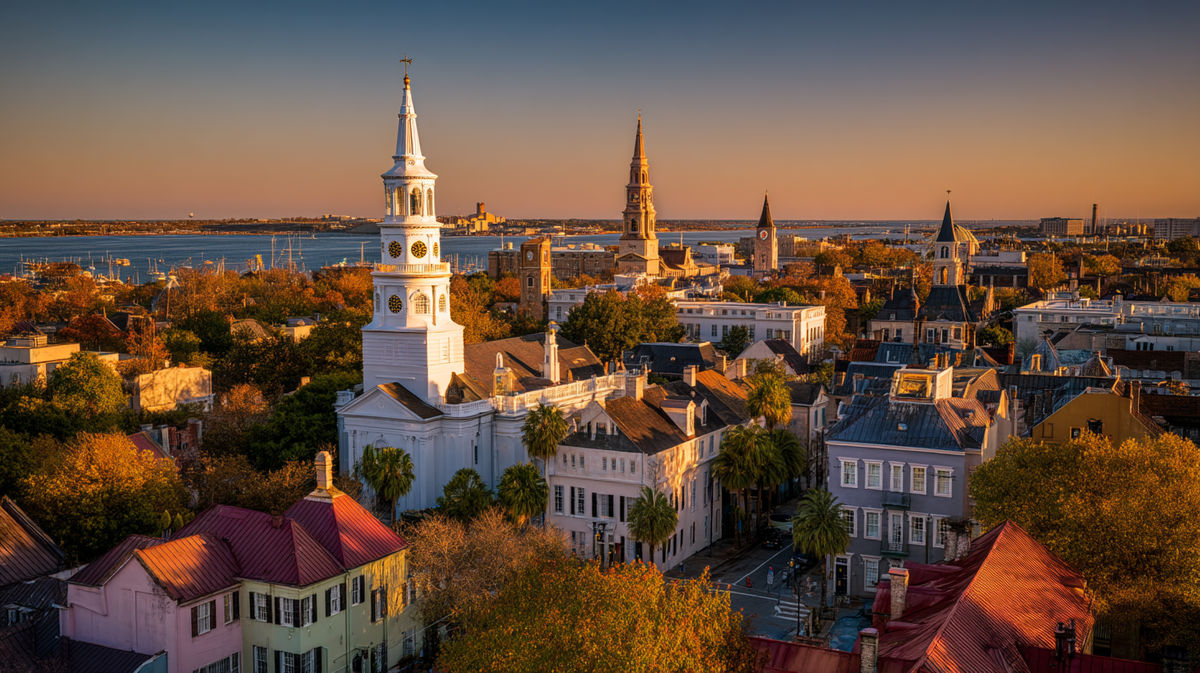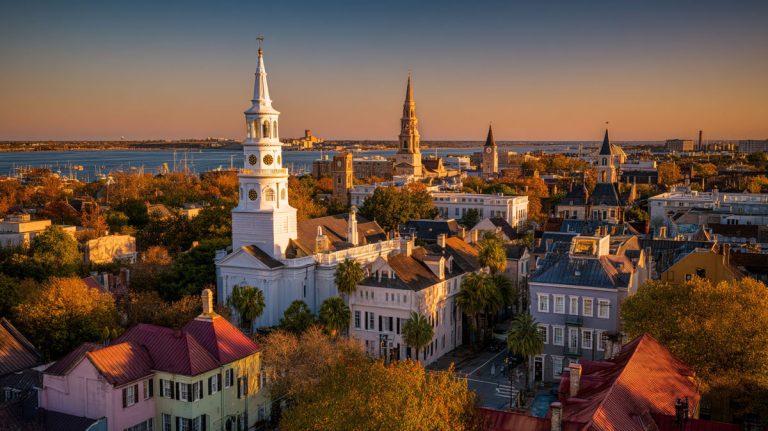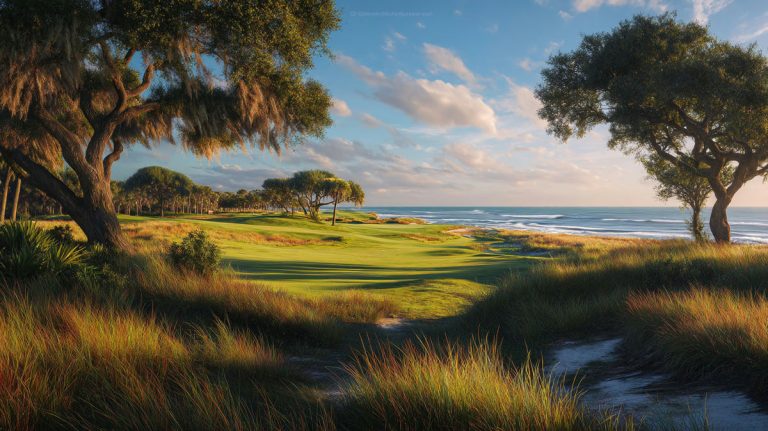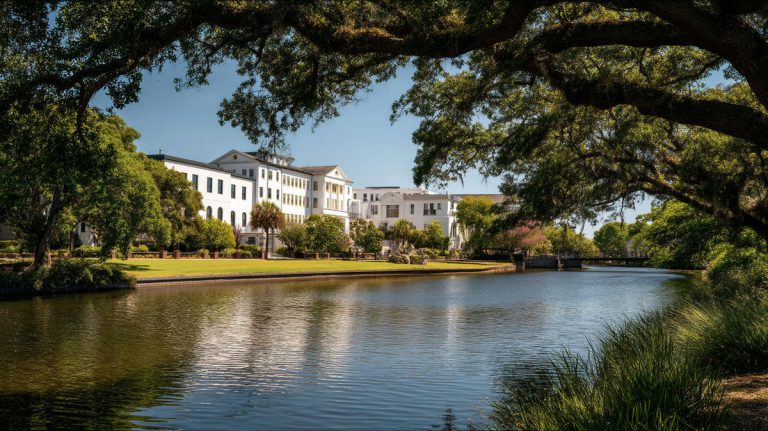How the Name Came to Be for This South Carolina City
Quick Answer
Charleston is called the Holy City because, from its earliest days, the port town welcomed a stunning mix of faiths and let each build visible landmarks.
Step off the ferry, and the first thing you’ll spot is a forest of church steeples poking through the skyline, more per square mile than almost anywhere else in the United States.
That skyline grew out of laws that protected religious freedom, a coastal topography that showed those steeples to incoming ships, and a local pride that still treats “many churches” as shorthand for identity.
Put simply, the city got its name because Charleston was known for letting every denomination, from Anglicans to Judaism, plant roots and keep them visible.
Introduction to Charleston’s Nickname
The Historic and Cultural Context
Ask a Charlestonian why Charleston is called the Holy City, and you’ll likely get a grin, a shrug, and a story about growing up in the Lowcountry of South Carolina, where Sunday bells compete with gulls for airtime.
The City of Charleston sits on a peninsula wedged between the Ashley and Cooper Rivers, a spot that drew settlers, traders, and eventually everyone from French Huguenots to Sephardic Jews. That collision of cultures shaped Charleston and gave Downtown Charleston one of the largest concentrations of churches in the country.
Even folks hunting homes for sale in Charleston end up talking about steeples before square footage. The nickname stuck because the place felt, and still feels, like a living lesson in the history of religious tolerance.
Religious Diversity in Charleston’s History
Early Settlement and Religious Freedom
When the Lords Proprietors issued the Fundamental Constitutions of Carolina in 1669, they baked religious tolerance into the colony’s DNA, promising settlers a voice regardless of creed.
That promise lured Anglicans, French Protestants known as Huguenots, Baptists, and Catholics, and it set the stage for one of the richest tapestries of faith in North America.
The policy wasn’t perfect, yet compared to other colonies, it let Charleston become a rare, somewhat tolerant city where a congregation could worship without constant fear of shutdown.
Most Beautiful Churches and Houses of Worship in Charleston
St. Michael’s Church
St. Michael’s anchors the famous “Four Corners of Law” at Broad and Meeting, and locals swear its 18th-century tower still sets the rhythm of downtown life.
Built between 1751 and 1761, the white-washed sanctuary is the oldest church building in the City of Charleston, and its English-made clock and bells have been marking weddings, hurricanes, and quiet Thursday mornings for more than 260 years.
Step inside and you’ll find box pews and a lofty gallery that feel unchanged since George Washington worshiped here during his 1791 tour.
St. Philip’s Church
Just up Church Street, St. Philip’s rises more than 200 feet, so high that its lantern once doubled as a federal lighthouse, guiding ships through Charleston Harbor until 1915. The present stuccoed sanctuary dates to 1836, but the congregation itself traces to the 1680s and played a key role in South Carolina’s early Anglican life.
St. Philip’s graveyard holds signers of the Constitution, governors, and generations of Charlestonians who helped the city earn its Holy City nickname.
The Cathedral of St. John the Baptist
The brownstone Cathedral of St. John the Baptist dominates lower Broad Street with soaring Gothic Revival arches designed by Patrick Keely in 1890.
Colored glass pours light across hand-carved altars, and the unfinished spire, long absent for want of funds, finally topped out in 2010, restoring the silhouette planners dreamed of a century earlier.
Today, the cathedral serves as the seat of the Roman Catholic Diocese of Charleston and welcomes travelers looking for quiet reflection amid the city’s bustle.
Circular Congregational Church
True to its name, Circular Congregational curves around a central pulpit on one of Charleston’s oldest pieces of real estate. English Congregationalists, Scots Presbyterians, and French Huguenots founded the congregation in the 1680s, making it a living emblem of religious diversity.
The current round sanctuary, rebuilt in 1892 after an 1861 fire, mixes Richardsonian Romanesque stonework with a wide, wood-vaulted ceiling that lets every voice in the congregation be heard without a microphone.
French Huguenot Church
Painted a soft pink rare in Gothic Revival, the French Huguenot Church stands as the only independent Huguenot congregation left in the United States.
Finished in 1845 and designed by Edward Brickell White, its lancet windows and delicate pinnacles reflect a French Protestant story that began with refugees fleeing persecution in the late 1600s.
Services are still conducted in English, but one special worship each spring is delivered in French to honor that heritage.
Emanuel African Methodist Episcopal Church
Known affectionately as Mother Emanuel, this 1891 Gothic structure represents the oldest African Methodist Episcopal Church congregation in the South.
Founded in 1816 by free and enslaved Black Charlestonians, the church became a cradle for civil-rights organizing and a beacon of resilience after the tragic 2015 shooting.
Visitors today are struck by the graceful twin towers, the warm welcome from parishioners, and the way Emanuel’s history of faith and perseverance embodies Charleston’s broader journey toward religious freedom.
The Skyline of Steeples
Iconic Churches and Their Architecture
Sailors once joked that if you could see St. Michael’s gleaming white spire, you were safely in harbor. The tower rises 186 feet, competing only with St. Philip’s, whose lantern climbed past 200 feet after 1850 and even carried a lighthouse beacon until 1915.
These landmarks survived earthquakes, hurricanes, and the Charleston Fire of 1861, which leveled whole blocks but couldn’t keep Charlestonians from rebuilding stone by stone. Their resilience explains why the skyline still shouts faith louder than finance, even as modern offices sprout around them.
How Steeples Became a Defining Feature
For two centuries, local leaders limited secular heights so the steeples of houses of worship stayed the tallest silhouettes.
Stand on the Battery and you’ll spot Anglican, Catholic, Jewish, and Greek crosses, or Stars of David, rising above pastel row houses.
With Charleston County flat as a fiddler crab, those spires doubled as navigation aids, guiding ships long before GPS. Add the legal quirks that froze building heights, and you get a panorama few other churches in the U.S. can match.
Charleston’s Religious Heritage Today
Preservation of Historic Churches
Because Charleston became a tourist magnet, preservationists rallied early. The result is a city where one of the oldest sanctuaries still hosts Sunday prayer, and even modest chapels earn museum-level care.
Grants from the Diocese of South Carolina, community bake sales, and studies by the University of South Carolina keep stained glass glowing and pipe organs humming.
The effort proves how deeply religion has shaped Charleston, architecturally and culturally.
Role of Religion in Community Life
Step inside any church in Charleston, and you’ll hear a choir that sounds like it’s been rehearsing since 1730.
Faith groups sponsor food drives, hurricane relief, and debates on racial justice. The diversity of denominations means you can attend a Lutheran Church fish fry on Friday, a Methodist hymn sing on Saturday, and Shabbat at KKBE the same weekend.
That rhythm underscores the city’s ongoing history of religious freedom and keeps the nickname alive city today.
Other Contributing Factors to the Nickname
Influence of Tourism and Marketing
Tour promoters have milked the nickname for well over a hundred years.
Picture an old-school postcard stand on East Bay around 1900, sepia skyline, “Holy City” scrawled in looping ink, ready for tourists to drop in the mail. Sightseers still count steeples the way kids hunt seashells, then blast the photos across socials, guidebooks, and travel blogs.
That steady buzz keeps Charleston framed as an easygoing, spiritually varied place where newcomers feel welcome, whether they’re lighting a candle or just scouting shrimp and grits.
Conclusion and Reflection on Charleston’s Identity
So, explain the origin of the nickname in one sentence?
Easy: Charleston welcomed every faith, let them build high, and never tore them down. But the longer story is better.
The history of religious struggle and cooperation, from French Huguenots finding refuge to Black Charlestonians forming the African Methodist tradition, forged a civic personality rooted in religious freedom.
Whether you’re admiring the cathedral of the diocese, touring KKBE, or just house-hunting, the Holy City aura lingers in every brick and bell chime.
Why did the city encourage so many steeples?
City fathers limited commercial height so steeples stayed visible to ships and symbolized moral guidance. That policy preserved the unique look that defines Charleston’s waterfront today.
Is Charleston really more tolerant than other Southern cities?
Historically, yes. The 1669 charter offered broader protections than most colonies, and by the 1700s, multiple faiths practiced openly side by side, a rarity in the colonial South Carolina era. Modern critics note gaps, but the legal foundation for religious tolerance set Charleston apart early.
Which is the oldest church in the South still standing?
St. Michael’s Church holds that honor.
Built in the 1750s, it survived wars, earthquakes, and fires, making it the oldest surviving religious building in Charleston and arguably the entire South Atlantic region.
Did any non-Christian faiths thrive here?
Absolutely. KKBE represents one of the oldest Jewish communities in America, and its Reform legacy began in Charleston, illustrating early acceptance of Judaism within a largely Christian port town.
How many churches operate in Downtown today?
Exact counts vary, but historians place the figure north of 150 within the peninsula alone. Truly one of the largest concentrations of active worship spaces per capita in the country, and the main reason the city today still answers to the Holy City nickname.






